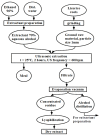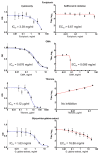Glycyrrhiza glabra L. Extracts and Other Therapeutics against SARS-CoV-2 in Central Eurasia: Available but Overlooked
- PMID: 37630394
- PMCID: PMC10458004
- DOI: 10.3390/molecules28166142
Glycyrrhiza glabra L. Extracts and Other Therapeutics against SARS-CoV-2 in Central Eurasia: Available but Overlooked
Abstract
In Central Eurasia, the availability of drugs that are inhibitors of the SARS-CoV-2 virus and have proven clinical efficacy is still limited. The aim of this study was to evaluate the activity of drugs that were available in Kazakhstan during the acute phase of the epidemic against SARS-CoV-2. Antiviral activity is reported for Favipiravir, Tilorone, and Cridanimod, which are registered drugs used for the treatment of respiratory viral infections in Kazakhstan. A licorice (Glycyrrhiza glabra) extract was also incorporated into this study because it offered an opportunity to develop plant-derived antivirals. The Favipiravir drug, which had been advertised in local markets as an anti-COVID cure, showed no activity against SARS-CoV-2 in cell cultures. On the contrary, Cridanimod showed impressive high activity (median inhibitory concentration 66 μg/mL) against SARS-CoV-2, justifying further studies of Cridanimod in clinical trials. Tilorone, despite being in the same pharmacological group as Cridanimod, stimulated SARS-CoV-2 replication in cultures. The licorice extract inhibited SARS-CoV-2 replication in cultures, with a high median effective concentration of 16.86 mg/mL. Conclusions: The synthetic, low-molecular-weight compound Cridanimod suppresses SARS-CoV-2 replication at notably low concentrations, and this drug is not toxic to cells at therapeutic concentrations. In contrast to its role as an inducer of interferons, Cridanimod is active in cells that have a genetic defect in interferon production, suggesting a different mechanism of action. Cridanimod is an attractive drug for inclusion in clinical trials against SARS-CoV-2 and, presumably, other coronaviruses. The extract from licorice shows low activity against SARS-CoV-2. At the same time, high doses of 2 g/kg of this plant extract show little or no acute toxicity in animal studies; for this reason, licorice products can still be considered for further development as a safe, orally administered adjunctive therapy.
Keywords: COVID-19; Cridanimod; Favipiravir; Glycyrrhiza glabra; Glycyrrhizin; SARS-CoV-2 virus; Tilorone; antivirals; influenza virus; licorice; phytochemicals.
Conflict of interest statement
The authors declare no conflict of interest.
Figures




References
-
- Ybrayev Z. COVID-19 in Kazakhstan: Economic consequences and policy implications. CAP PAPER. 2020;234:5–12.
-
- COVID-19 Crisis Response in Central Asia. [(accessed on 4 August 2023)]. Available online: https://www.oecd.org/coronavirus/policy-responses/covid-19-crisis-respon...
-
- Electronic Source. [(accessed on 4 August 2023)]. Available online: https://covid19.trackvaccines.org/country/kazakhstan/
-
- Takeshita M., Fukuyama H., Kamada K., Matsumoto T., Makino-Okamura C., Uchikubo-Kamo T., Tomabechi Y., Hanada K., Moriyama S., Takahashi Y., et al. Potent SARS-CoV-2 neutralizing antibodies with therapeutic effects in two animal models. iScience. 2022;25:105596. doi: 10.1016/j.isci.2022.105596. - DOI - PMC - PubMed
MeSH terms
Substances
Grants and funding
LinkOut - more resources
Full Text Sources
Medical
Miscellaneous

